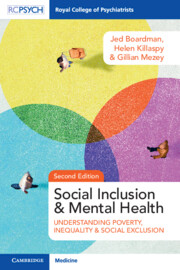Book contents
- Social Inclusion and Mental Health
- Reviews
- Social Inclusion and Mental Health
- Copyright page
- Contents
- Foreword to Second Edition
- Foreword to First Edition (2010)
- Preface
- Acknowledgements
- Chapter 1 Introduction: Poor, Excluded, and Unequal
- Section 1 Social Exclusion, Poverty, and Inequality
- Chapter 2 Social Exclusion: Basic Concepts
- Chapter 3 Social Exclusion: Applying the Paradigm to People with Mental Health Conditions – Key Aspects
- Chapter 4 Poverty and Deprivation: Getting Under the Skin
- Chapter 5 Poverty, Deprivation, and Social Exclusion in the United Kingdom
- Chapter 6 Poverty, Inequality, and Health
- Chapter 7 Social Policy, the Welfare State, and Social Exclusion
- Chapter 8 Mental Health Services and Policy in the United Kingdom
- Section 2 Participation of People with Mental Health Conditions
- Section 3 Including People
- Index
- References
Chapter 7 - Social Policy, the Welfare State, and Social Exclusion
from Section 1 - Social Exclusion, Poverty, and Inequality
Published online by Cambridge University Press: 24 November 2022
- Social Inclusion and Mental Health
- Reviews
- Social Inclusion and Mental Health
- Copyright page
- Contents
- Foreword to Second Edition
- Foreword to First Edition (2010)
- Preface
- Acknowledgements
- Chapter 1 Introduction: Poor, Excluded, and Unequal
- Section 1 Social Exclusion, Poverty, and Inequality
- Chapter 2 Social Exclusion: Basic Concepts
- Chapter 3 Social Exclusion: Applying the Paradigm to People with Mental Health Conditions – Key Aspects
- Chapter 4 Poverty and Deprivation: Getting Under the Skin
- Chapter 5 Poverty, Deprivation, and Social Exclusion in the United Kingdom
- Chapter 6 Poverty, Inequality, and Health
- Chapter 7 Social Policy, the Welfare State, and Social Exclusion
- Chapter 8 Mental Health Services and Policy in the United Kingdom
- Section 2 Participation of People with Mental Health Conditions
- Section 3 Including People
- Index
- References
Summary
This chapter covers the development of social policies and the modern Welfare State. Welfare states represent recognition that the key welfare needs of the country will be met by the state through the provision of income transfers and key public services. Their development has been closely associated with the expansion of citizenship and human rights. In the UK the Poor Law was a long-lasting historical core on which the nation’s welfare state was built, and was associated with the important infrastructure of local authorities, health systems, and education along with the provision of payments in times of need. A well-functioning welfare state is important for the wellbeing of the population and has valuable redistributive roles. They provide social investment in children’s early lives and guard against social risks such as unemployment and poverty. They have the potential to assist economic growth and to provide the infrastructure and support for human capital, such as through the creation of a ‘healthy workforce’. Generally, the more egalitarian states perform better on a range of well-being measures. They remain a central pillar of the maintenance and improvement of the quality of life of people with disabilities associated with mental health conditions.
Keywords
- Type
- Chapter
- Information
- Social Inclusion and Mental HealthUnderstanding Poverty, Inequality and Social Exclusion, pp. 141 - 160Publisher: Cambridge University PressPrint publication year: 2022

